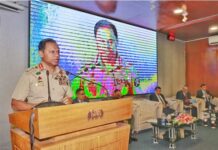The JMJB opened many camps in Rajshahi region to train up their followers

Photo- Dhaka Tribune
Islamist militants in the country took inspiration from the ideals of al-Qaeda, the Afghan Taliban and other similar outfits of Pakistan to preach radicalism, train their activists and carry out organised terrorist attacks across the country in the past three decades.
When this correspondent interviewed militant leaders Abdur Rahman and Siddiqul Islam – the latter became widely known as Bangla Bhai – in May 2004, they said how they had been inspired by Taliban.
Abdur Rahman had said: “Our model includes many leaders and scholars of Islam. But we will take as much [ideological elements] from the Taliban as we need.”
At that time Rahman and Bangla Bhai were carrying out terror activities in northern Rajshahi region with the blessings of the then BNP-Jamaat administration under the banner of Jagrata Muslim Janata Bangladesh (JMJB) hiding their outfit’s original name Jama’atul Mujahideen Bangladesh (JMB).
Both the outfits were banned and Rahman and Bangla Bhai along with four other militant leaders were executed in 2007 for their terrorist acts.
Rahman, Bangla Bhai and other top leaders of the JMB used to motivate and train up new recruits using the literature and video of al-Qaeda and Taliban activities. The recruits were given video discs of speeches of al-Qaeda leader Osama Bin Laden and footage on warfare training in militant camps in Afghanistan.
The JMJB opened many camps in Rajshahi region to train up their followers.
Other militant outfits, such as the banned Harkat-ul-Jihad-al Islami, their founders and leaders also had direct link with Taliban and al-Qaeda, and the Pakistan-based Lashkar-e-Taiba – all with the same goal of spearheading a movement based on “jihad.”
In July 2004, law enforcers arrested 32 Islamist militants, raiding a mosque in southern district of Barguna. The militants were conducting a training at the mosque and the law enforcers recovered books on jihad, other printed materials including a booklet on how to operate AK-47 rifles. Some of the printed materials contained pictures of Osama and his messages on jihad. There were plenty of reports in the past decade on such recovery.
Jamaat-e-Islami’s founder Pakistani Abul A’la Maududi’s book was also found from many militants.
Very recently investigators discovered a new militant group named Ansarullah Bangla Team who are inspired by Anwar al-Awlaki-led al-Qaeda in the Arabian Peninsula. Another banned Islamist outfit Hizb-ut Tahrir also inspired by their international network.
Apart from these, inspiration and support also came from militant or armed insurgent outfits based in Pakistan, Myanmar and India.
A JMB leader named “Boma” Mizan told law enforcers after his arrest that he had been trained in bomb-making by radical Islamist Rohingya outfits.
According to investigation findings, Pakistan-based Lashkar-e-Taiba’s (LeT) Arges grenades were used by Bangladesh militants to kill former finance minister SAMS Kibria in January 2005. Similar LeT grenades were used with an aim to kill Awami League chief Sheikh Hasina in 2004.
After the 10-truckloads arms haul in 2004 it became also clear that some influential leaders of the BNP, Jamaat and a few military officials who served in the Directorate General of Forces Intelligence (DGFI) and the National Security Intelligence (NSI) had links with Indian insurgent group United Liberation Front of Assam (Ulfa) for whom they had smuggled the huge consignment of modern arms and ammunition.
Investigation into the haul found Pakistan’s Inter-Services Intelligence (ISI) had a role in the smuggling. The ISI, which is widely known for patronising militancy in Afghanistan, Pakistan and India, also has close links with Bangladeshi militants, observes a researcher.
Although the BNP-Jamaat-led government had denied and brushed aside a report of Time magazine published in 2002 that again came to light after the recent release of al-Qaeda leader Ayman al-Zawahiri’s audio tape with a call for Bangladeshi Muslims to wage jihad.
Time magazine journalist Alex Perry wrote in 2002: “According to a source inside a Bangladeshi Islamic group with close ties to al-Qaeda, al-Zawahiri arrived in Dhaka in early March and stayed briefly in the compound of a local fundamentalist leader. It’s unclear how al-Zawahiri came to be in Bangladesh, or whether he’s still there. However, a source in the Directorate General of Forces Intelligence (DGFI), a Bangladeshi military intelligence agency, told TIME that al-Zawahiri is believed to have left Bangladesh this summer, crossing over the eastern border into Burma with Rohingya rebels. U.S. intelligence, however, has no evidence this report is true.”
Interestingly, in 2006 the then government of Khaleda Zia invited Perry to Bangladesh and arranged a trip with Khaleda by a helicopter across the country to make a positive report on her government, especially to give an impression that her government was combating militants.
Security analyst Maj Gen (retd) Abdur Rashid told the Dhaka Tribune: “It is true militants of many foreign militant and terrorist groups travelled to Bangladesh in the past because the then government did not have a zero-tolerance policy on the militants and terrorists and so different government agencies even helped them travel to the country.”
Asked if militants could still enter the country, Gen Rashid said: “No, now the state has a zero-tolerance stance against militants and terrorists, and so it is not possible for them to travel to Bangladesh.”
Source: Dhaka Tribune









